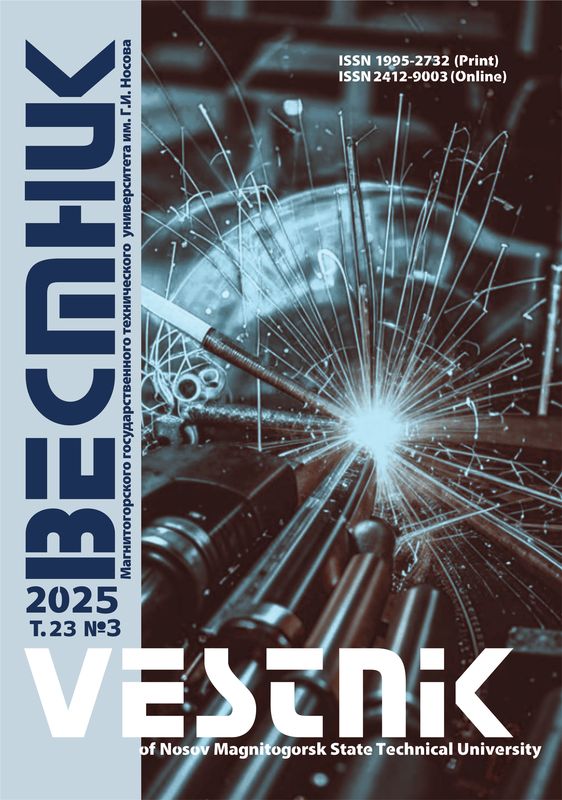Abstract
The paper studies longitudinal strains occurring along the height of a cylindrical object as a result of the temperature difference along the cylinder radius. It describes a particular case of a thermal stress state, when heating a cylinder. A temperature field was measured, when solving an axisymmetric task of heating a cylindrical object. Using the existing analytical dependence, the authors identified mathematical relations to calculate normal, tangential, and equivalent stresses. Such procedure may be applied to determine a stress state of cylinders 0.1 and 0.05 m in radius, when heating up to 400°C. It is shown that changes in a cylinder radius, maintaining the same heating conditions, result in decreasing maximum tension stresses from 45.9 to 23.9 MPa, and compressive stresses from 43.1 to 22.5 MPa. The authors determined principal stresses along a cylindrical rod radius during heating. Applying the Huber–Mises–Hencky criterion, changes in a growth rate of the stress state along a cylinder radius was determined. It is found that at the point of equalizing temperature along the cylinder radius, the highest stresses are in the layer periphery and central areas of the object under study and amount to 40.5 MPa at set conditions of calculations. It is noted that the developed mathematical tool may be used to evaluate a thermal stress state of mill rolls during their heat treatment.
Keywords
Temperature field, radial coordinates, thermal stress state, principal stresses, temperature strains, strength conditions.
1. T.K. Roy, B. Bhattacharya, C. Ghosh, S.K. Ajmani. Advanced high strength steel. Springer Nature Singapore Pte Ltd, New York, 2018.
2. R.B. Hetnarski. Encyclopedia of thermal stresses. Springer Dordrecht Heidelberg, New York, 2014.
3. R.B. Hetnarski, M.R Eslami. Thermal stresses – advanced theory and applications. Springer, New York, 2009.
4. N. Fonstein. Advanced high strength sheet steels. Springer, New York, 2015.
5. V. V. Kharchenko. Strength of materials. Springer, New York, 2014.
6. A. Davies. Handbook of condition monitoring. Springer, New York, 1998.
7. Kolokoltsev V.M., Sinitskiy E.V., Savinov A.S. Modeling temperature fields, when producing castings. Vestnik Magnitogorskogo gosudarstvennogo tekhnicheskogo universiteta im. G.I. Nosova [Vestnik of Nosov Magnitogorsk State Technical University], 2015, no. 1, pp. 39–43. (In Russ.)
8. Savinov A.S., Kolokoltsev V.M., Ibragimov F.G. Identification of the thermal stress with a temperature gradient in a plane casting wall. Stal [Steel], 2014, no. 4, pp. 156–160. (In Russ.)
9. Kuznetsov G.V., Sheremet M.A. Raznostnye metody resheniya zadach teploprovodnosti [Difference methods of solving heat conduction problems]. Tomsk: TPU Publishing House, 2007, 172 p. (In Russ.)
10. Savinov A.S., Dyachenko D.Ya., Frolushkina K.A. Calculation of temperature deformations, when cooling a plate. Mekhanicheskoe oborudovanie metallurgicheskikh zavodov [Mechanical equipment of metallurgical plants], 2012, no. 1, pp. 177–180. (In Russ.)
11. Durelli A., Riley W. Vvedenie v fotomekhaniku [Introduction to photomechanics]. Moscow: Mir, 1970, 423 p. (In Russ.)
12. Abramov V.V. Ostatochnye napryazheniya i deformatsii v metallakh [Residual stresses and deformations in metals]. Moscow: MASHGIZ, 1963, 355 p. (In Russ.)
13. Darkov A.V., Shpiro G.S. Soprotivlenie materialov [Strength of materials]. Moscow: Vysshaya shkola, 1975, 654 p. (In Russ.)
14. Stepin P.A. Soprotivlenie materialov [Strength of materials]. Moscow: Vysshaya shkola, 1975, 654 p. (In Russ.)












